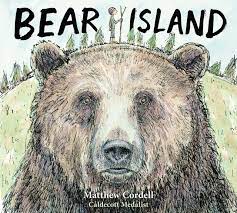 Bear Island by Matthew Cordell
Bear Island by Matthew Cordell
Louise is grieving the death of her family’s dog Charlie. One day, while visiting an island where she used to have fun with Charlie, Louise encounters a bear. Initially, she’s terrified, but in her grief, she’s also angry, and she takes out that anger by roaring at the bear. The bear leaves Louise alone and she realizes that the bear is also sad. After that, Louise frequently returns to visit the bear and they both gradually heal. Then it’s time for the bear to go into hibernation and Louise experiences a sense of loss all over again. While this story is less interesting than some of the others on the list, and the pen illustrations aren’t particularly eye-catching or fun, the discussion of emotions and the poignant simplicity of the text make this a great choice if you’re specifically looking for books that might help a young child process grief and loss.
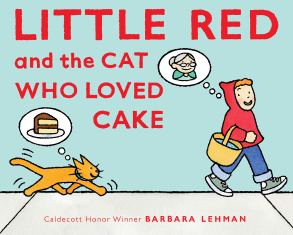 Little Red and the Cat Who Loved Cake by Barbara Lehman
Little Red and the Cat Who Loved Cake by Barbara Lehman
This nearly-wordless picture book is a fractured fairy tale based on Little Red Riding Hood with references to several other well-known folk and fairy tales and quite a few nursery rhymes. Conveniently, those references are listed in the final four pages. Preschoolers will enjoy referring to the list and treating this as a Seek-and-Find book. They will also be entertained by the various twists this book gives to the Little Red Riding Hood story, which include changing the wolf to a cat, changing the cookies to a cake, and changing the forest to a city setting. Spoiler alert: This version is also significantly less violent than the original; no grandmas, wolves, or cats were hurt in the telling of this story.
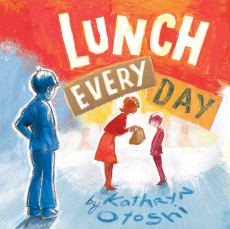 Lunch Every Day by Kathryn Otoshi
Lunch Every Day by Kathryn Otoshi
Told from the perspective of a bully, this picture book expresses the important if somewhat trite message that an act of kindness can change a person for the better. The first-person narrator, later addressed as Jimmy, has made a habit of grabbing Skinny Kid’s lunch every day. (Skinny Kid’s real name is never specified) It comes as a surprise when Skinny Kid invites Jimmy to his birthday party, but an even bigger surprise comes when Skinny Kid’s mom asks Jimmy what he wants for lunch tomorrow. From then on, she sends a second lunch to school for Jimmy every day. Although most children aren’t in a position to try out this mother’s solution to bullying for themselves, the story will still have appeal for elementary-school-age children, especially if they haven’t previously read stories told from a bully’s perspective. The subject matter and the stylized illustrations are unlikely to hold much appeal for readers younger than about second grade.
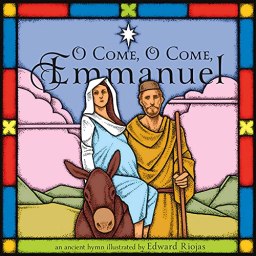 O Come, O Come, Emmanuel illustrated by Edward Riojas
O Come, O Come, Emmanuel illustrated by Edward Riojas
For the most part, I try to read and review relatively popular mainstream books for this blog. Occasionally, I’ll write about books that are a little less well-known just because I was able to get my hands on them when they were brand new. I generally don’t review obscure books from small publishers unless I actually read an ARC before it was published. But now that I have a daughter and I have my own reasons for choosing certain books for her, I’m occasionally making exceptions and including little-known books just because we love them and I’d like to think I’m helping spread the word. We purchased this particular book (two copies, one in English and one in Latin) because I decided that I’d like to start a new family tradition in which we mark the beginning of the Advent season by giving our child a seasonally-appropriate religious gift. The text in this book is the words of the familiar Advent hymn O Come, O Come, Emmanuel, and the stained-glass-style illustrations include not only aspects of the nativity, but also Jesus’ crucifixion and death. Since our daughter is only five months old, we’ve been using this book in place of an Advent devotional. She enjoys books that can be sung and she loves the colorful illustrations. I’m looking forward to sharing this book with her again in future years when she’s old enough to understand more. I highly recommend it for teaching children the significance of the Advent season.
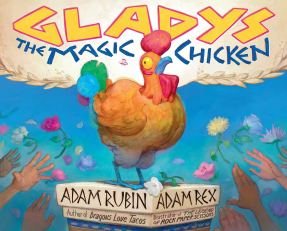 Gladys the Magic Chicken by Adam Rubin, illustrated by Adam Rex
Gladys the Magic Chicken by Adam Rubin, illustrated by Adam Rex
Gladys was a chicken who lived in ancient times, “three thousand years before your grandma’s grandma’s grandma was born.” She likes the follow the sheep, dog, and Shepherd Boy and she is there on a fateful day when the Shepherd Boy sees his reflection and is horrified by his ugliness. Years later, when he again sees his reflection and realizes that he is now good-looking, he assumes that Gladys is a magical chicken who has granted his wish. He trades her away to a traveling merchant. The rest of the book follows Gladys as she changes hands again and again, each time getting credit for a character’s wish come true. This goofy story strikes a balance between repetition and surprises, which makes it feel like a folk tale. Thanks to the inclusion of princesses, pirates, and a mysterious Lone Rider, this book has a wide variety of appeal factors. This book also has some degree of educational value on several counts. The repetition of the fact that it takes place in “ancient times” could be helpful for young students who are just beginning to conceptualize the idea of different time periods, and the underlying theme about causation could be used to teach budding scientists some important concepts. Or just use this book as a funny story to entertain kids!
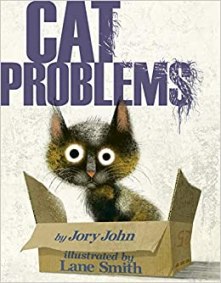 Cat Problems by Jory John, illustrated by Lane Smith
Cat Problems by Jory John, illustrated by Lane Smith
Cat lovers will thoroughly enjoy the accuracy of this cat’s personality as he complains about the hardships of life as a cat. (“You’re in my spot… Now you’re in my other spot. Now you’re in my thrd spot.”) This poor cat has to survive on only nineteen hours of sleep and sometimes even has to eat dry food. But then a talkative squirrel explains just how good the cat’s life is. Does that change his perspective? Well, not really. The moral comes across a little heavy-handed, but the humor makes this book entertaining anyway. Recommended for newly independent readers around ages five to eight, but could also be read aloud to younger children.
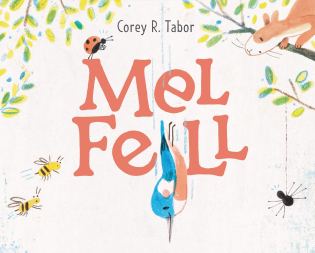 Mel Fell by Corey R. Tabor
Mel Fell by Corey R. Tabor
In this simple, feel-good story, Mel is a young kingfisher bird leaving the nest for the first time. Despite her own fears and her siblings’ concerns, she steps out of the nest and dives straight down. She falls past various tree-dwelling animals before diving into the water and catching a fish before triumphantly flying back to her nest. Not until the author’s note on the final page are young readers informed that this “fall” is characteristic of kingfishers. There is an implied message about the nature of success and failure, but even taken simply at face value, this is a fun and inspirational story that would be easy to work into a storytime about birds or about learning new things. An additional fun feature is that reading this book requires turning it sideways. The book must be rotated while reading the page in which Mel is underwater. This inventive layout is likely to make the book a crowd favorite among preschool audiences.
 Opposites Abstract by Mo Willems
Opposites Abstract by Mo Willems
As the title implies, this is a concept book that uses abstract pictures to illustrate pairs of opposites. Although it includes a few obvious ones, such as light/dark, this book also includes quite a few concepts that aren’t typically included in opposite books, such as individual/groups and intentional/accidental. I personally find it surprising that this book is being marketed for babies and toddlers. Although it has few words and bright illustrations with strong color contrast, the very idea of an abstract concept book is something that will hold more appeal for parents than for young children. For anyone who does choose this book to share with a child, I recommend reading it one-on-one and discussing why each picture illustrates the indicated concept.